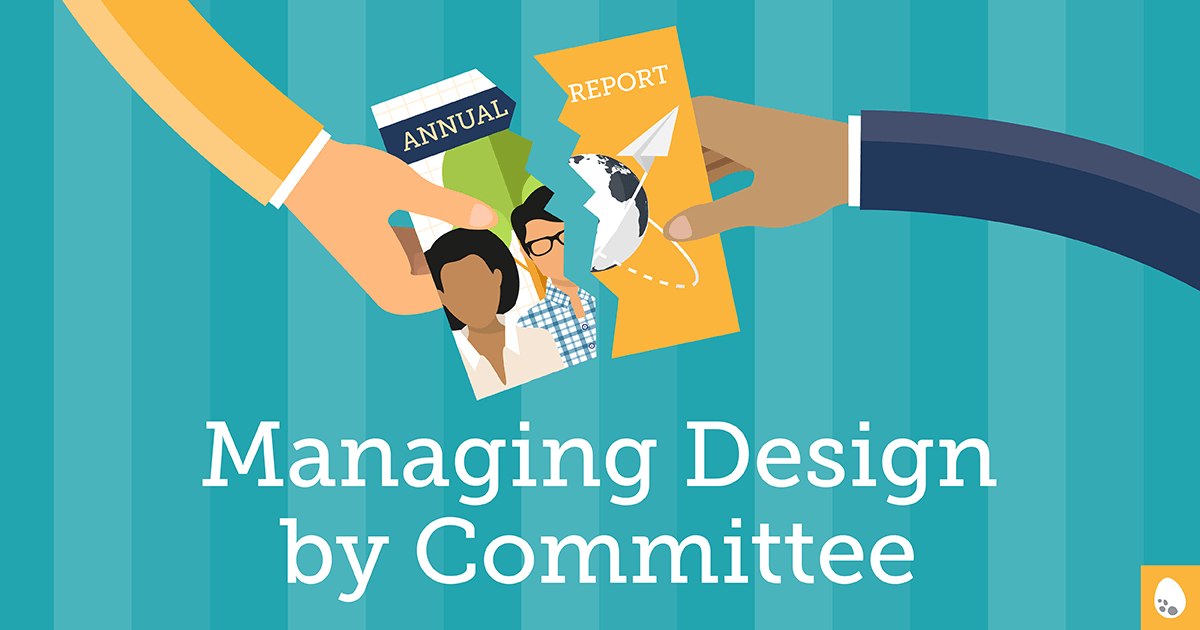You know the cliché about too many cooks in the kitchen…it often rings true when a committee is involved in the full design process. But when it comes to special projects in the non-profit world, it’s a hard scenario to avoid.
While it’s valuable to gather feedback from a variety of viewpoints, it’s important to filter through it quickly and not get hung up on the wrong things. Don’t let your project stall out because the committee can’t agree if the cover page should be cherry red or brick red.
Here are some pointers to help better manage the precarious “Design by Committee” process:
1. Choose a leader
It’s great that everyone involved has the chance to voice their opinion, but at the end of the day, someone needs to have the final say.
Without a firm decision maker, projects can:
- Fall behind schedule: indecision stalls the process.
- Cost more: conflicting opinions and unclear vision lead to more concepts and revisions by a designer.
- Waste your committee’s time: no one wants to sit through excessive meetings because the “leader” is trying to appease everyone.
Listen to the group. Glean the key bits of feedback. Make a decision if there’s not a consensus.
2. Determine the key message and tone at the start
Before delving into creative executions, write down what the piece needs to convey – essentially a creative brief. What’s the overarching message? Who are you speaking to? What emotions do you want to express? Is it hope? Warmth? Innovation?
Hint: Don’t get into specific imagery at this stage unless it’s absolutely critical to include a certain graphic.
You may want to start this on your own or involve a designer or committee to help you work through it. The goal is to get everyone on the same page up front. I’m not saying it’s going to be easy but it’s better to have the discussions and debates at the start, otherwise you’ll end up wasting time later on.
Once the key message and tone are agreed upon by all parties, put it in writing. This vision becomes the foundation which will guide the creative process.
It’s also a way to keep things on track. If you reach a point in the creative review process where committee members start throwing out suggestions that are off course or get nit picky with inconsequential details, rein things in by reminding everyone of what was agreed upon at the outset and what aspects truly impact the piece.
3. Curate what gets presented
When it comes time for the initial creative presentation, fight the temptation to present EVERYTHING you receive from the designer (if there are many choices, that is).
For example, if the designer provides you with 4 different concepts, present 2 (or even 1 if you feel there’s a strong contender) to the committee. Act as a curator.
The more options you show, the less focused the group will be. It creates more room for conflicting opinions. Cut the choices down from the beginning and save time for everyone involved.
Unable to whittle down the choices? Ask your designer which they feel are the strongest concepts and why. Whether you agree with them in the end or not, at least you have more information to help make a decision.
4. Don’t create a “Franken-concept”
There’s value in getting a variety of perspectives when it comes to reviewing creative, but it can quickly become a counterproductive exercise if everyone around the table starts playing art director. Art is subjective and who doesn’t love the chance to add their two cents on how something might be improved?
It’s especially troublesome when you end up with a divided committee. As a means of compromise, things meld together. We’ve all seen it; use a little from Concept A with a piece from Concept B… and the dreaded “Franken-concept” is born.
On rare occasion, it works out, but combining two separate ideas often results in a diluted, muddled concept.
Rather than forcing together two “aren’t quite working” ideas, step back and revisit the creative brief. With a review of the original goals, you may find that one of the concepts can be salvaged with some adjustments or perhaps a new creative direction is the best way forward.
For tips on how to provide your designer with effective feedback, check out my post here.
Design by Committee is not an easy venture but by having more awareness and control over the process, you can create a smoother transition from concept to approval.
